|
Throughout
the years, some types of Chess notation
or languages were developed in order to
record the position of the pieces on the
Chessboard or the moves being made
during a Chess game. This is typically
done by indicating the current piece and
square location and where the piece is
being moved to. It also enables us to review
great Chess games played by actual
Grandmasters and from other Chess
players of the past, allowing you to go back over
their games and learn from them. Also,
learning Chess notation is a must
to compose or study Chess problems and to be able to
understand
any kind of Chess book. |
|
Piece symbols
and letters used in Chess diagrams |


K = King |


Q
= Queen |


R
= Rook |


B
= Bishop |


N = Knight |


(no letter) |
|
K,
Q,
R,
B,
and N
must always
be written down in capital letters |
|
Other
shorthand symbols used in Chess notation |
|
Symbol |
Description |
|
+
or
ch |
Check |
|
0-0 |
Kingside Castling |
|
1-0 |
White won the game |
|
½ -½ |
Game drawn |
|
e.p. |
en passant move |
|
! |
Good move |
|
? |
Bad move |
|
+/= |
Slight advantage for
white |
|
+/- |
Advantage for white |
|
+- |
White decisive
advantage |
|
= |
Even position or
draw |
|
|
|
Symbol |
Description |
|
#
or
++ |
Checkmate |
|
0-0-0 |
Queenside Castling |
|
0-1 |
Black won the game |
|
* |
Game in progress |
|
x
or
: |
Capture |
|
!! |
Very good move |
|
?? |
Very bad move |
|
=/+ |
Slight advantage for
black |
|
-/+ |
Advantage for black |
|
-+ |
Black decisive
advantage |
|
Kt
or
N |
Knight |
|
|
Algebraic
Notation System |
|
Based on a system developed by Philipp
Stamma, the Algebraic notation system uses the
coordinates of the 8x8 square grid of
the Chessboard and it is now the
standard among most Chess players and
organizations. The first
horizontal row of the white pieces is
used for the denomination of all
columns. The squares of such
columns are named from left to right
with the letters: a, b, c, d, e, f, g,
and h. The first vertical column
is used for the denomination of all
ranks. The squares of such ranks
are named from down to up with the
numbers: 1, 2, 3, 4, 5, 6, 7, and 8, see Fig.
3. The diagram on Fig. 4 shows
the unique numeration for all the
squares on the Chessboard, and Fig. 5
illustrates the current coordinates position
on the board of
both white and black Kings. |
|
Chessboard with
coordinates |
|
Algebraic numeration for all
64 squares |
|
White King is at c3
and black King is at f7 |
|
Short Algebraic
Chess Notation |
|
This is
the most popular form of the Algebraic
system which is also called Standard
Algebraic notation. This type of notation omits
to annotate the starting file and rank
location of the piece
being moved and instead, the piece name
and destination square are only annotated, see Fig.
6. The
letters naming the
Chess pieces
are always written in upper-case letters
and the coordinates letters of the board are
always written in lower-case.
The letter ‘P’ for Pawn is never used
and only the destination file and rank
coordinates are recorded. |
|
Short Algebraic notation
of the above position |
|
1. e4
e5 |
2. Nf3
Nc6 |
3. Bb5
... |
|
Move |
White |
Description |
Black |
Description |
|
1. |
e4 |
White
moves Pawn to e4 |
e5 |
Black
moves Pawn to e5 |
|
2. |
Nf3 |
White
moves Knight to f3 |
Nc6 |
Black
moves Knight to c6 |
|
3. |
Bb5 |
White
moves Bishop to b5 |
... |
... |
|
Long Algebraic
Chess Notation |
|
Although
long Algebraic notation is no longer
recognized by FIDE as of 1981, computer
programs and some Chess players use this
variant of fully expanded Algebraic
notation because it has the benefit of
clarity, particularly for players
learning the game or less skilled. This
notation is almost identical to short
Algebraic but it has the advantage of
recording where a piece comes from in
addition to the one it moves to. A
hyphen is added between the two, for
example: 1. c2-c4 instead of short
Algebraic 1. c4. Also, an “x” is used to annotate a
capture: 12. Nf3xd4 versus short
Algebraic: 12. Nd4 (or Nxd4). |
|
Long Algebraic notation
of the above position |
|
1. c2-c4 e7-e5 |
2. Nb1-c3
d7-d6 |
3. Ng1-f3
Bc8-g4 |
|
Move |
White |
Description |
Black |
Description |
|
1. |
c2-c4 |
White
moves Pawn to c4 |
e7-e5 |
Black
moves Pawn to e5 |
|
2. |
Nb1-c3 |
White
moves Knight to c3 |
d7-d6 |
Black
moves Pawn to d6 |
|
3. |
Ng1-f3 |
White
moves Knight to f3 |
Bc8-g4 |
Black
moves Bishop to g4 |
|
Figurine Algebraic
Chess Notation |
|
Another
Algebraic notation variation which is
gaining popularity, is called Figurine
Algebraic Notation. Twelve pictorial
representations or symbols to
represent the pieces are used
instead of letters: six for the white
pieces and six for the black pieces (Fig.
8). It was first used by Count Robiano in 1846 and
was called ‘notation parlante’. By
changing the letters to small
pictures representing the pieces, we can have an
international language understood by all Chess players worldwide. This method has
mostly been popularized by newspapers
and other periodicals in Chess published
articles and games. |
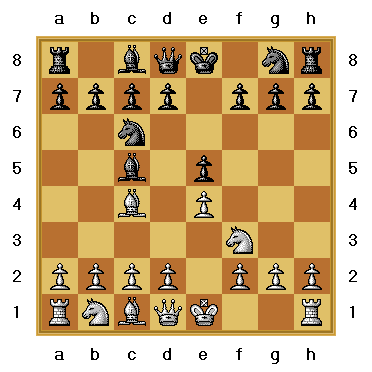
|
Figurine Algebraic notation
of the above position |
|
1. e4 e5 |
2.
 f3 f3
 c6 c6 |
3.
 c4 c4
 c5 c5 |
|
Move |
White |
Description |
Black |
Description |
|
1. |
e4 |
White
moves Pawn to e4 |
e5 |
Black
moves Pawn to e5 |
|
2. |
 f3 f3 |
White
moves Knight to f3 |
 c6 c6 |
Black
moves Knight to c6 |
|
3. |
 c4 c4 |
White
moves Bishop to c4 |
 c5 c5 |
Black
moves Bishop to c5 |
|
Descriptive
Chess Notation |
|
This type
of Descriptive notation (also called
English notation), was once the most popular
notation in English and Spanish speaking
countries until at least the late 70’s
and is still used by some older players.
Although Descriptive notation
is no longer as popular as Algebraic
notation, it is very useful to learn it
because there are hundreds of old books
from past Chess players using this
Descriptive system. Rather than using
letters for the columns, the board is
divided into King-side and Queen-side
squares, see fig. 10. Numbers are used
for the ranks but each player starts
from 1 to 8 from his relative position.
Thus, the Algebraic move 1. e4 e5 is
equal to 1. P-K4 P-K4 in Descriptive
notation and is represented
by the move number (1.), the piece’s name (P), a hyphen (-),
and the destination square (K4).
Unlike Algebraic notation, Descriptive
notation
always uses the letter ‘P’ to name Pawns. |
|
Descriptive numeration for all
64 squares |
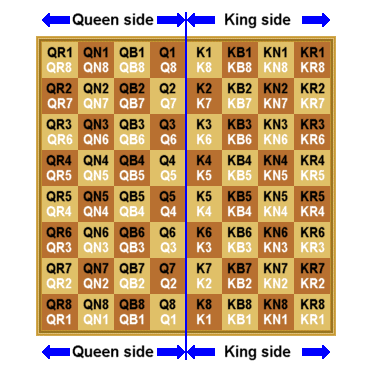 |
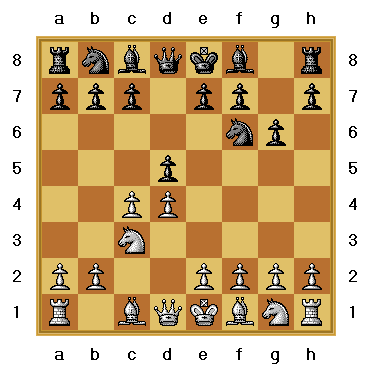
|
Descriptive notation
of the above position |
|
1. P-Q4 N-KB3 |
2. P-QB4
P-KN3 |
3. N-QB3
P-Q4 |
|
Move |
White |
Description |
Black |
Description |
|
1. |
P-Q4 |
White
moves Pawn to d4 |
N-KB3 |
Black
moves Knight to f6 |
|
2. |
P-QB4 |
White
moves Pawn to c4 |
P-KN3 |
Black
moves Pawn to g6 |
|
3. |
N-QB3 |
White
moves Knight to c3 |
P-Q4 |
Black
moves Pawn to d5 |
|
The
Forsyth-Edwards Notation (FEN for
short), is the standard notation or
method for describing Chess positions or
a particular board position of a Chess
game. It was created in 1883 by newspaper
journalist David Forsyth from Scotland
and slightly extended later by an
American computer scientist Steven J.
Edwards for use in
computer Chess software. The main
purpose of FEN notation files is to provide all the information
required to restart a game from a
desired Chess position.
Typical FEN string showing the Chessboard
initial position:


A FEN string is made up of 6 fields:

FEN strings
contain separators between fields using
blank spaces:

Field #1: Chess pieces setup:
This
field number 1 is comprised of 8 strings
or sections of letters and numbers
separated by slashes ( / ):

Each
string or section represents a rank or a
row of 8 squares of the Chess board
running from left to right and starting
from the uppermost section of the board
(black pieces).
Every rank is filled up with letters taken from the standard English names:
“P”= Pawn, “N”= Knight, “B”= Bishop,
“R”= Rook, “Q”= Queen, “K”= King, and
numbers from 1 to 8. White pieces are
identified by uppercase letters (PNBRQK)
and black pieces by lowercase letters
(pnbrqk). Adjacent or contiguous empty
squares are identified with a single
digit number (1 to 8), e.g.: a whole
empty row of 8 squares should be
represented by an “/8/”, not as
“/1/1/1/1/1/1/1/1/” and this also
applies to any other lower amount of
contiguous empty
squares in a row.
The
following image is an alternate way of
visualizing the board with the above FEN
file:
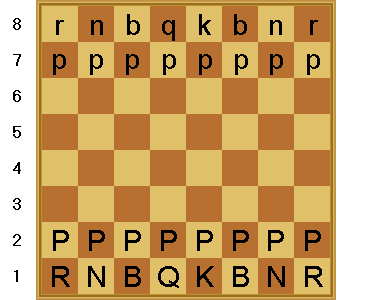
Field #2: Active player or color:
The
field #2 represents the active color or
to indicate which player moves next. Letter “w” means white moves next,
letter “b” means black moves next.
 |
|
Field #3: Castling availability:
Field #3
(KQkq) indicates castling options for
both colors and can have one or more
letters: “K” (white can castle
Kingside), “Q” (white can castle
Queenside), “k” (black can castle
Kingside), and “q” (black can castle
Queenside). If neither side can castle, this is
“-”.

Table below shows all
possible options for field #3:
|
KQkq |
White and black can castle
either side |
|
KQk |
White can castle either side,
black kingside |
|
KQq |
White can castle either side,
black queenside |
|
Kkq |
White can castle kingside, black
can castle either side |
|
Kk |
White and black can castle
kingside |
|
Kq |
White can castle kingside, black
can castle queenside |
|
KQ |
White can castle either side,
black is not allowed to castle |
|
K |
White can castle kingside, black
is not allowed to castle |
|
Qkq |
White can castle queenside,
black can castle either side |
|
Qk |
White can castle queenside,
black can castle kingside |
|
Qq |
White and black can castle
queenside |
|
Q |
White can castle queenside,
black is not allowed to castle |
|
kq |
Black can castle either side,
white is not allowed to castle |
|
k |
Black can castle kingside, white
is not allowed to castle |
|
q |
Black can castle queenside,
white is not allowed to castle |
|
- |
Neither side
is allowed to castle |
|
|
Field #4: En passant:
Field
#4 targets the en passant square in algebraic notation
and is the position “behind” the Pawn if
it has just made a two-square move. If there
is no en passant target square, this is
annotated as “-”. Should be recorded regardless of whether there
is a Pawn in position to make an en passant capture.

|
|
Field #5: Halfmove clock:
This
field shows the number of half-moves since the last
Pawn advance or capture. It is used to determine if a draw can be claimed under the fifty-move rule.

|
|
Field #6: Fullmove number:
The number of the full moves
or a complete move pair. It starts at 1 and it is incremented after
black’s move.

|
|
Regardless of the Chess notation a
player chooses or likes, he should have
the means to write down his Chess moves
and games. In Chess tournaments, players
are required to record the moves in a
Chess score sheet. This effectively
allows players and officials to visually
follow and recreate all moves made
during a game in case there is a
discrepancy or a dispute such as an
illegal move, three-fold repetition,
fifty-move rule, etc. Another good reason
for writing down your Chess games is
that enables you to replay your moves
later
for further study and analysis by
pointing out mistakes and improving your
Chess. Fig. 14 below shows a copy of the
original score sheet from “The
Game of the Century” played between
Byrne and Fischer on the Rosenwald
Memorial of 1956 written in Descriptive
notation. |
|
Score
sheet / Byrne vs. Fischer |
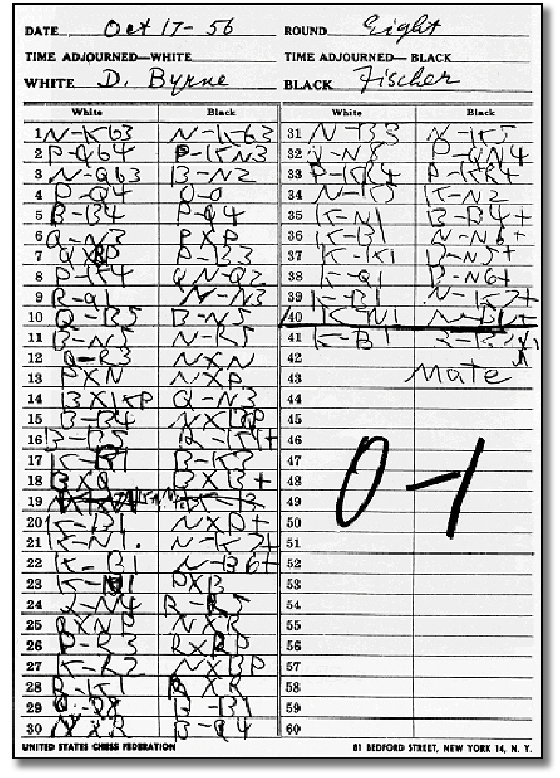
|
Fig. 14
Click here
to download a printable Chess Score Sheet |
|
More about Chess
Notation
Promotion
is annotated in Algebraic notation using
an equal sign, e.g., d8=Q. In
Descriptive notation there are several
accepted ways of doing so: with
parentheses: P-K8(Q), or a slash:
P-K8/Q, or with an equal sign: P-K8=Q.
In
Descriptive, the move 1. KP-K4 ... can always
be written as 1. P-K4 ... since only that Pawn
can move to K4. The normal full
designation for the piece or a file can
be shortened to just the last part
providing this does not produce
ambiguity.
When
annotating moves during a game, the move
number is written first, followed by the
white move and then the black move. When
white or black makes a move and the
sequence needs to be interrupted to
embed a follow up or a commentary, an
ellipsis (...) should be placed to
denote it: Algebraic Notation - 12. Bxd6
... (for white) or 12. ... Ne5 (for
black), and in Descriptive notation -
12. BxQ6 ... (white) or 12. ... N-K4
(black).
In both
Algebraic and Descriptive notation, when
a player has the option to capture a
piece with two own pieces, e.g., with two
Knights, an extra character should be
added to avoid confusion: Algebraic -
Nfxd4 (if both Knights are on rank 3) or
N6xd4 (if both Knights are on c column),
and in Descriptive notation - N(K)xP and
N(6)xP respectively.
|
|